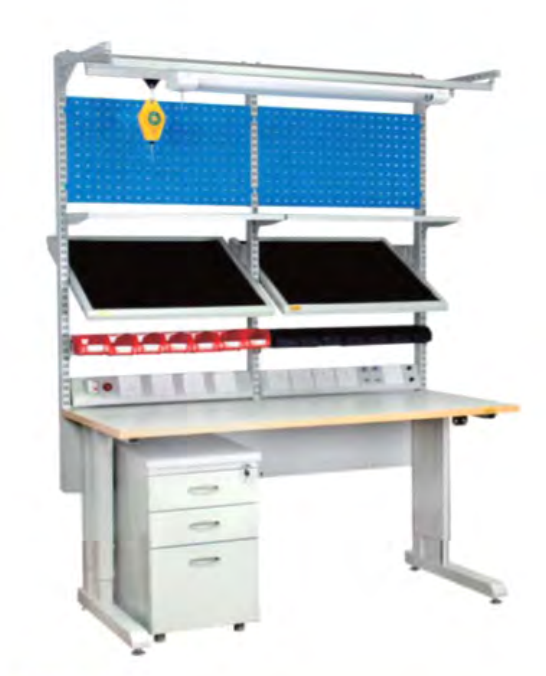ESD workbenches serve as essential components for controlling static electricity within electronics assembly lines as well as repair workshops and laboratories. The specialized workbench functions to safeguard delicate electronic components against static electricity discharge damage. This complete tutorial analyzes the materials which compose ESD workbenches together with their unique characteristics as well as their designated applications.
This particular material collection demonstrates excellent properties which include both fire resistance together with durability alongside static control capabilities.
Fire resistance together with durability and static control determine the selection of materials for ESD workbenches. Multiple evaluation standards confirm the workbenches effectively protect workers and technology from static build-up and operational tolerance across different industrial situations.
Fire Resistance
Any material used for workbenches in fire-risk environments should have strong resistance to fire when operating in flammable material areas or hot conditions. Wildfires and flame propagation need to be controlled through appropriate materials in order to establish safety at workplaces.
Carbon Steel: The performance of carbon steel under high temperatures improves when fire-resistant coatings are applied to its surface. Its tendency to corrode does not prevent companies from choosing this material because of its strong structural features.
Stainless Steel: Stainless steel stands out from carbon steel since it provides both excellent corrosion resistance together with good flame protection properties. The material is commonly utilized in locations which demand both cleanliness performance together with low maintenance requirements.
Durability
Durability is another vital aspect. DS workbenches need to face ongoing operation together with weight-bearing conditions combined with regular part relocations and tool movements. A long-term durable materials selection becomes essential to optimize the value of these specialized workbenches.
Plastic Laminates: High-pressure laminates (HPL) serve as surfaces for workbenches because they stand up to heavy use and cleaning tasks easily. The materials demonstrate resistance against water exposure as well as chemical agents and withstand the impact of physical forces.
Solid Phenolic Resin: The material stands out because of its robust nature and its abilities to withstand moisture while defending against chemical substances which makes it the top selection in laboratory spaces and cleanrooms.
Static Control
The fundamental function of ESD workbenches exists to control static electricity discharge. A selection of suitable materials should possess capabilities to safely discharge static charges in order to reduce ESD risks.
ESD Laminates: ESD Laminates have a specific structure which maintains a tested path to ground and safely discharges electrical charges.
Composite Surfaces: When used for static-dissipation the advanced composite materials present both high durability and efficient ESD control capabilities.
Graphite-Infused Tabletops
The ESD workbench industry identifies graphite-infused tabletops as unique components because they merge several beneficial features.
Static Control
The tabletop surface incorporates graphite as a natural conductive material that increases its capability to release static charges. The surface successfully performs ESD control tasks because of its high effectiveness levels.
Strength and Durability
The graphite infusion strengthens the tabletop structure thus boosting its ability to resist mechanical damages. The workbench maintains sustainable function because of its strong durability which supports intensive use and extended operational life.
Maintenance and Cleanliness
Graphite-infused surfaces remain easy to maintain and retain non-porous properties thus accounting for critical cleanliness factors in highly hygienic spaces. This smooth finish on the tabletop operates as a barrier that successfully blocks any accumulation of dust or other contamination substances.
Corrosion-Resistant Coatings
Resistance to corrosion stands as a vital aspect when choosing materials for ESD workbenches particularly in production areas that handle corrosive chemicals and moisture-filled environments. Manufacturers treat different material bases with corrosion-resistant protective layers to extend the operational lifetime and preserve structural quality.
Protective Layers
●Epoxy Coatings: The epoxy coating serves as a popular protective solution because it shows superior resistance to chemicals combined with strong moisture protection suitable for harsh environments.
●Powder Coatings: A free-flowing coating powder applies before processing under heat until it becomes cured. These protective coverings provide strong corrosion protection and exist in multiple coloring options.
Improved Performance
Coatings not only protect the base material from corrosion, but can also increase other properties such as fire resistance and stable control. By selecting the appropriate coating, manufacturers can tailor ESD workbench to meet the specific requirements of various industries.
Environment friendly
Modern corrosion-resistant coatings are designed to be environmentally friendly, reduce toxic runoff and provide safe work conditions. It aligns with increasing emphasis on stability in industrial practices.
Finally, materials used in ESD workbench are carefully chosen to offer a combination of fire resistance, durability and static control. From carbon steel and stainless steel to advanced composite and graphite-infected surfaces, its place is based on specific requirements of each material. Corrosion-resistant coatings further enhance the lifetime and performance of these workbenches, ensuring that they meet the rigorous demands of various industries.







